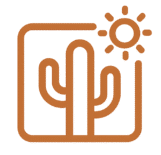Creating a thriving desert garden isn’t just about choosing the right drought-tolerant plants – it’s also about inviting the right visitors. Pollinators like bees, butterflies, hummingbirds, and even certain types of beetles and moths play a vital role in helping your garden bloom. In the arid desert climate, attracting these pollinators might seem like a challenge, but with a few strategic choices, you can transform your garden into a buzzing, fluttering oasis.

Why Pollinators Matter in the Desert
Pollinators are essential for plant reproduction. Many fruits, vegetables, and native flowering plants rely on them to transfer pollen from one bloom to another. In the desert, where conditions can be harsh and biodiversity more fragile, supporting pollinators means supporting the health of the entire ecosystem – including your own garden. Native pollinators are especially efficient at working with native plants, which have evolved alongside each other over thousands of years. That’s why encouraging native species of bees or butterflies can lead to better flower production and even increased seed yield.
Choose the Right Plants
One of the most important steps to attracting pollinators is selecting the right flowers. You want plants that not only survive in the desert heat but also offer nectar and pollen throughout multiple seasons. Here are some great pollinator-friendly plants for desert gardens:
- Desert Marigold (Baileya multiradiata): A tough perennial with bright yellow flowers that attract bees and butterflies.
- Penstemon (Penstemon spp.): With tubular red or pink flowers, this plant is a favorite of hummingbirds.
- Desert Willow (Chilopsis linearis): This small tree offers trumpet-shaped flowers that bees and hummingbirds adore.
- Milkweed (Asclepias spp.): Crucial for monarch butterflies, milkweed provides both nectar and a place for butterflies to lay eggs.
- Globe Mallow (Sphaeralcea ambigua): A resilient wildflower with orange or pink blooms perfect for native bees.
When designing your garden, aim to plant in clusters. A group of the same plant species is easier for pollinators to find than scattered individuals. Also, include a mix of flower shapes, sizes, and blooming times to attract a variety of pollinators throughout the year.
Provide Water and Shelter
Pollinators need more than just flowers. Especially in desert climates, a clean and safe water source is essential. Try adding a shallow dish of water with pebbles for insects to land on, or use a small drip system to keep a moist area in the garden. Shelter is another factor. Native bees, for instance, often nest in the ground or in small holes in wood. Leave patches of bare soil undisturbed, or install bee hotels made from bamboo or drilled blocks of wood. Don’t over-mulch your garden – it can prevent ground-nesting bees from settling. For butterflies, consider planting host plants in addition to nectar sources. These are plants where they lay their eggs and caterpillars feed. Desert milkweed, for example, serves both purposes for monarchs.
Avoid Pesticides
Even organic or “natural” pesticides can harm beneficial pollinators. If you need to manage pests, opt for integrated pest management (IPM) techniques – like introducing predatory insects or using physical barriers. If chemical use is unavoidable, apply treatments early in the morning or late in the evening when pollinators are less active, and always avoid blooming flowers.
Add Color and Height
Color is crucial for attracting pollinators. Bees are especially drawn to blue, purple, white, and yellow flowers. Hummingbirds prefer red, orange, and pink. Butterflies are more generalists, but they still love bold, bright displays. You can also use vertical space to make your garden more inviting. Flowering vines like trumpet vine or native honeysuckle attract hummingbirds and can grow on trellises or fences, creating visual interest and pollinator pathways.
Create a Year-Round Habitat
While spring and summer are peak pollination seasons, many desert pollinators are active nearly year-round. Include winter-blooming plants like aloe or fairy duster to provide off-season food sources. Even in the colder months, some native bees may remain active, and hummingbirds often overwinter in milder desert areas. By offering something for every season, you support a sustainable ecosystem and enjoy color and life in your garden throughout the year.
Final Thoughts
Attracting pollinators to your desert garden doesn’t just benefit the plants – it enhances the entire environment. Your garden becomes more vibrant, resilient, and alive. With a thoughtful mix of native plants, water sources, and a pesticide-free approach, you can create a pollinator paradise in even the most arid landscape. Whether you’re in the early stages of designing your desert garden or looking to add a little more life to an existing space, start thinking like a bee – or a hummingbird – and build a home they’d love to visit.
